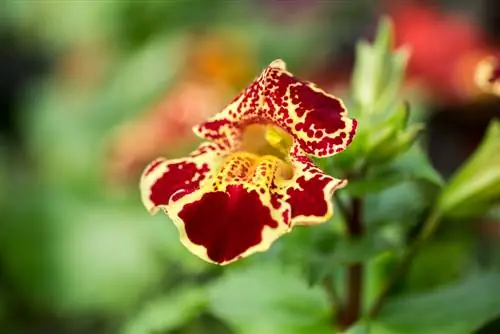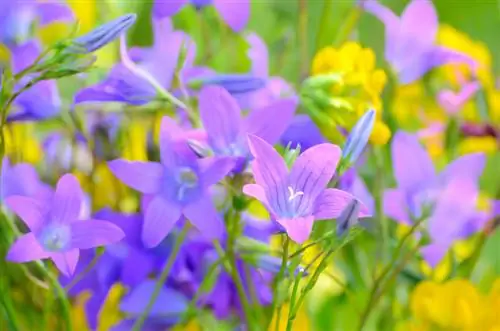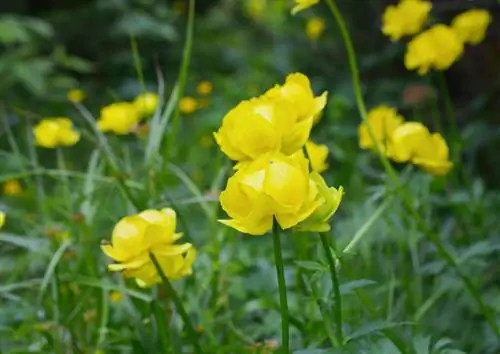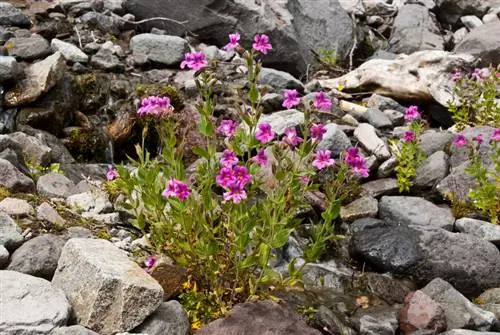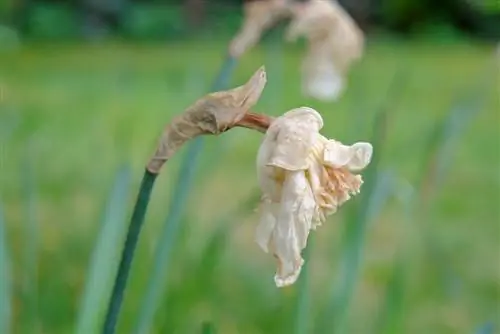- Author admin [email protected].
- Public 2023-12-25 17:45.
- Last modified 2025-01-23 11:21.
Judge flowers, which are sometimes also referred to as monkey flowers, have become an integral part of the colorful edges of garden ponds. Their flowers add color to the garden. To ensure a particularly long flowering period, the plants require appropriate care measures. If the location is not right, the flowers will be less lush.

How to care for a juggler flower in the garden?
Judge flowers, also called Mimulus, are herbaceous plants with bright, often spotted flowers. They prefer moist locations, grow in partially shaded conditions and bloom between June and September. Care measures: regular watering, moderate fertilization and removing dead shoots.
Origin
Judge flowers are a genus of plants with the scientific name Mimulus. While the species used to belong to the figwort family, they are now part of the juggler flower family. The genus includes 150 to 170 species that differ greatly in growth habit, size and flower color. Mimulus luteus, which is also known as the juggler flower, is a common ornamental plant alongside the spotted juggler flower (Mimulus guttatus).
The main distribution area of the genus is in Australia and western North America. There are other natural habitats in South America, South Africa and Asia. Mimulus luteus grows on wet meadows in Chile.
Natural habitats:
- humid locations
- Forests and forest edges
- Riverside areas on bodies of water and rivers
Growth
Most Mimulus species grow as herbaceous plants that are annual or perennial. There are few juggler flowers that develop partially woody shoots. Within the genus, most species are land plants and only a small proportion are aquatic plants that develop submerged leaves or grow above the water surface. Mimulus luteus is an upright growing marsh plant that grows between 30 and 40 centimeters high.
leaves
Judge flowers develop opposite leaves that are ovoid or rounded. The tip of the leaf blade is bluntly rounded. While many species develop an entire leaf margin, the edges of the leaves of Mimulus luteus are covered with small teeth. They are green in color and are two to three centimeters long.
Bloom
Mimulus species develop individual flowers in the leaf axils or raceme-shaped inflorescences at the end of the shoot. The flowers are hermaphroditic and fivefold. They consist of a green calyx tube from which the corolla tube protrudes. What is striking are the five raised ribs that extend over the individual sepals. The corolla tube ends with two lips. The lower lip consists of three downwardly directed or forwardly curved lobes, which represents an optimal landing place for insects. Two fused upright or backwards curved petals act as the upper lip.
Flowering time
The juggler flower, cultivated as an ornamental plant, blooms between June and September. Its crown is bright yellow and has characteristic red spots that mark the way to the flower throat. Up to six large individual flowers can be found on one stem.
Fruit
In autumn, the flower stalks bear capsule fruits that contain numerous seeds. They are tiny and are scattered when they move in the wind.
Usage
The yellow-flowering juggler flower decorates water gardens and, due to its location requirements, is particularly suitable for planting along banks and pond edges. It is particularly effective in the foreground because its flowering period lasts a long time. The plants can be planted in larger tuffs and harmonize with tormentol, pitchflower or various sour grasses.
Is juggler flower poisonous?
There is no evidence that juggler flowers develop toxic plant substances. The spotted juggler flower is traditionally used in Bach flower therapy and is used to combat fears, hypersensitivities and stress.
Which location is suitable?
Mimulus luteus is an undemanding plant that feels particularly comfortable in moist locations. It prefers to grow in partially shaded conditions and also thrives in sunny locations outside of the blazing midday sun. A few hours of sunshine in the morning and evening promote flower formation.
What soil does the plant need?
A moist to wet substrate offers the plant optimal growth conditions. It likes nutrient-rich soil that is occasionally flooded.
Propagate juggler flower
Older juggler flowers have developed a large root ball that can be divided in early spring. To do this, the bale is dug up and chopped up with a knife or spade. At the new location, the partial plants must be watered well so that they grow quickly.
Sowing
In autumn, the almost ripe seed capsules can be cut off and air-dried for a few days. Then place the capsules in an airtight container that you can store in a cool, dry place over the winter. Next autumn, the seeds are scattered on growing substrate and lightly covered with soil. In a bright place with temperatures around 15 degrees, the seeds will begin to germinate after 14 days if the substrate was kept evenly moist.
Cuttings
You can take top cuttings from the plant in early summer. The shoots should be 15 centimeters long. Remove the lower leaves before placing the shoots in potting soil. Alternatively, you can encourage the head cuttings to form roots in a glass filled with water. A warm location promotes rooting, which begins after just a few days. As soon as a bushy root system has developed, the young plants are placed in a planter with a mixture of soil and sand.
What is the best time to plant?
Young plants grow in the cultivation container until spring. If no late frosts are expected, the juggler flowers are planted outdoors. The ideal time is after the Ice Saints. Before placing the plant in the prepared planting hole, the rootstock should be watered thoroughly. After planting, a thick layer of mulch is spread over the substrate, which protects the young plants from drying out.
The correct planting distance
If you want to plant several juggler flowers in small groups, you should ensure a distance of 20 to 30 centimeters between the individual plants.
Jerker flower in pot
Jerker flowers are cultivated in pots as annuals. Plant the plants in a large zinc tray along with other marsh plants. The mini moor requires little care and can be left to its own devices. Drainage is also not necessary as the plants rely on wet conditions. The juggler flower self-sows in the fall so that fresh plants grow next spring. Make sure that the moor bed does not dry out. To prevent the bucket from freezing in winter, it should be protected with foil or kept frost-free over the winter.
Pond
Juggler flowers can easily be planted on moist soil or directly in shallow water in the bank edge zone. The water depth is between five and ten centimeters. The excavated material should not be mixed with compost, otherwise the water will become eutrophic. Plant the plant between larger stones. They act as a natural dispersal limit and prevent the juggler flower from displacing smaller species. Since the plants do not tend to overgrow, a plant basket is not necessary. Mimulus luteus feels particularly comfortable in the company of marsh forget-me-nots and marsh marigoldsread more
Watering the juggler flower
As swamp plants, juggler flowers have a high water requirement. Your root ball must not dry out during the growing season. There is constant moisture near the pond. For bedding or potted plants, you have to use the watering can regularly. The sunnier the location, the more water juggler flowers need. In the blazing midday sun, the need for water increases rapidly. If there is a lack of water, the plants will wither very quickly.
Fertilize the juggler flower properly
If the location is near the pond, the plants are not fertilized. There is a risk that rain will wash too many nutrients into the water and cause it to overturn. Container or bed plants can be fertilized every two weeks. Guano or liquid fertilizer is suitable for this.
Cut the juggler flower correctly
You can regularly cut off spent shoots to encourage the development of new flowers. If you aim to sow yourself, a few flower stalks should always be left standing and ripening. Once the plant has completely wilted, it can be cut back to the ground. This will prevent dead plant parts from ending up in the water and being decomposed by organisms.
How do I transplant correctly?
Well-grown stocks become more beautiful over the years and should not be transplanted. If there is no longer enough space for the juggler flowers, you can divide the root ball and plant the partial plants in a new location. This will rejuvenate the stock. Such measures stimulate the development of new shoots and roots.
hardy
Jerky flowers can survive mild winters without winter protection. When temperatures drop significantly into the double-digit minus range, an insulation layer made of straw, leaves and brushwood makes sense. Potted plants are stored in a protected location outdoors or in a frost-free winter quarters. The root ball must be kept moist during the dormant phase. In spring, the potted plants are acclimated to the outdoor conditions. From March onwards, place the pot in a shady place during the day and in the winter quarters in the evening. The final relocation outside will take place in mid-May.
Conditions in winter quarters:
- cool temperatures around ten degrees
- dark place
- high humidity
read more
Pests
In spring, the fresh shoots of the juggler flower are on the menu of snails. Check the bed regularly for snails and collect them. Sharp-edged stones serve as a barrier. You can also spread old coffee grounds on the substrate. The roasted aromas deter the voracious pests. This defensive measure is not suitable for plants near water. Coffee grounds contain a lot of nitrogen, which contributes to the eutrophication of the water.
Effective measures against snails:
- Apply special nematodes before planting
- Distribute beer traps with lids in the garden
- Set up barriers: pottery shards, snail collars or fences
Tip
If your juggler flower's ability to bloom leaves something to be desired, give it a guano stick (€13.00 on Amazon). The nutrients promote the development of new flowers.
Varieties
- Tigrinus Grandiflorus: Grows clumpy, not hardy. Flowers yellow with brown-red spots, between June and September. 25 to 30 centimeters high.
- Red Emperor: Mimulus cupreus variety with intensely colored flowers, bright red. Flowering period from June to September. Reaches heights between 20 and 30 centimeters.
- Orange Glow: Mimulus cupreus variety that forms a dense carpet. Flowers are orange-red from June to September. Between 15 and 20 centimeters high.
- Mimulus guttatus: Upright or arching. Flowers bright yellow. Between 30 and 50 centimeters high.

